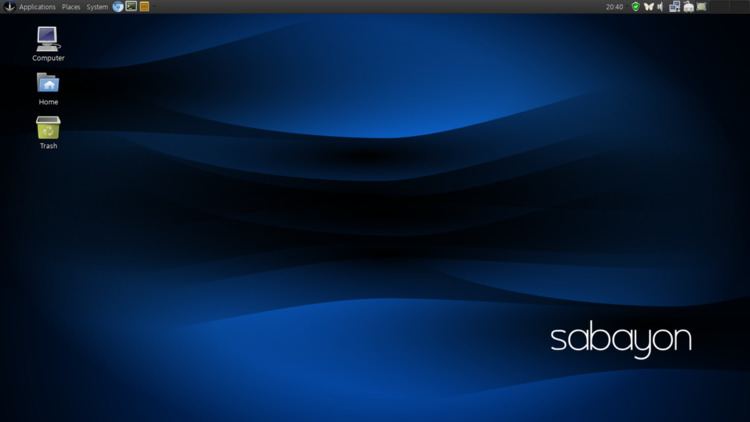Working state Current | Source model Mixed | |
 | ||
Developer Fabio Erculiani and Team Initial release 28 November 2005 (2005-11-28) Latest release (Rolling release) 16.02 / January 29, 2016; 13 months ago (2016-01-29) | ||
Sabayon Linux or Sabayon (formerly RR4 Linux and RR64 Linux), is a Gentoo-based Italian Linux distribution created by Fabio Erculiani and the Sabayon development team. Sabayon follows the "out of the box" philosophy, aiming to give the user a wide number of applications ready to use and a self-configured operating system.
Contents
Sabayon Linux features a rolling release cycle, its own software repository and a package management system called Entropy. Sabayon is available in both x86 and AMD64 distributions and there is support for ARMv7 in development for the BeagleBone.
It is named after an Italian dessert, zabaione, which is made from eggs. Sabayon's logo is an impression of a chicken foot.
Editions
Since version 4.1, Sabayon has been released in two different flavors featuring either the GNOME or KDE desktop environments, with the ultralight Fluxbox environment included as well. (In the previous versions all three environments were included in a DVD ISO image).
Since Sabayon's initial release, additional versions of Sabayon have added other X environments, including Xfce and LXDE. A CoreCD edition which featured a minimal install of Sabayon was released to allow the creation of spins of the Sabayon operating system; however, this was later discontinued and replaced by CoreCDX (fluxbox window manager) and Spinbase (no X environment) first and by "Sabayon Minimal" later. A ServerBase edition was released which features a server-optimized kernel and a small footprint, but this was later discontinued and integrated into the "Sabayon Minimal".
Daily build images are available to the Sabayon testers, but are released weekly to the public on the system mirrors containing stable releases. Official releases are simply DAILY versions which have received deeper testing. The adoption of Molecule led the team to change the naming system for releases.
Currently available versions are:
Derivatives
Additional X window managers may also be installed from the Sabayon repositories, such as Cinnamon and Razor-qt.
Configuration
Sabayon uses the same core components as the Gentoo Linux distribution. Sabayon now uses systemd. All of the Gentoo configuration tools, such as etc-update and eselect are fully functional. Sabayon also includes additional tools for automatic configuration of various system components such as OpenGL. Sabayon provides proprietary video drivers for both nVidia and ATI hardware. These are enabled if compatible hardware is found; otherwise, the default open-source drivers are used. Because of the automatic driver configuration, the compositing window manager Compiz Fusion and KWin are used for the GNOME and KDE editions, respectively. The discovery and configuration of network cards, wireless cards, and webcams is similarly automatic. Most printers are detected automatically but require specific manual configuration through the CUPS interface.
Package management
Sabayon Linux relies on two package managers. Portage is inherited from Gentoo, while Entropy was developed for Sabayon by Fabio Erculiani and others. Portage downloads source-code and compiles it specifically for the target system, whereas Entropy manages binary files from servers. The binary tarball packages are precompiled using the Gentoo Linux unstable tree. Entropy clients then pull these tarballs and perform the various post- and pre-compilation calls of the Gentoo ebuild to set up a package correctly. This means the system is completely binary-compatible with a Gentoo system using the same build configuration. The adoption of two package managers allows expert users to access the full flexibility of the Gentoo system and others to easily and quickly manage software applications and updates. The Entropy software features the ability of allowing users to help generate relevant content by voting and by attaching images, files and web links to a package.
Rigo application browser is a new GUI front end to Entropy that is the successor to Sulfur (aka Entropy Store). Taking on a "less is more" approach, Rigo is designed to be simple and fast. During an interview with Fabio Erculiani he described Rigo as a ”Google-like” Applications Management UI. Rigo handles system updates, package searching, install/removal of packages, up/down voting of packages, and many other common Entropy tasks. Rigo is currently available in the sabayon weekly repository.
Applications
The number of applications installed by default is higher for DVD editions than for editions small enough to fit on a CD. Their selection is also tailored to the choice between GNOME, KDE, Xfce, and MATE. The XBMC environment can be run without loading the full desktop environment.
The following table summarizes the software included in GNOME, KDE, Xfce, and MATE versions:
Considerable software is also available in the main repository.
Many Microsoft Windows executables are automatically run in Wine.
Other applications include Adobe Reader, Audacity, Clementine, aMSN, Celestia, Eclipse, FileZilla, GnuCash, Google Earth, Inkscape, Kdenlive, Mozilla Firefox, Mozilla Sunbird, Mozilla Thunderbird, Nero Burning ROM, Opera, Picasa, Skype, Teamviewer, VirtualBox, Vuze and Wireshark.
Games (open-source and proprietary) include Doom 3, Eternal Lands, Nexuiz, OpenArena, Quake, Quake 2, Quake 3, Quake 4, Sauerbraten, The Battle for Wesnoth, Tremulous, Unreal, Unreal Tournament, Urban Terror, Vendetta Online, Warsow, Warzone 2100, Wolfenstein: Enemy Territory, World of Padman and Xonotic.
Installation
Although the distribution is a LiveDVD (or a LiveCD for LXDE, CoreCDX, SpinBase and ServerBase) it can be installed on a hard disk once the system is fully booted. Sabayon Linux uses the Calamares installer. In previous releases, Anaconda and the Gentoo Linux Installer were used. Installation is designed to be simpler than is typical for Gentoo, which requires more extensive knowledge of the operating system (particularly for the compilation of the Linux kernel). Installation takes up to 30 minutes depending on the speed of the DVD drive. Those without a DVD drive can install the GNOME and KDE versions through a USB drive, which can be created with Unetbootin. A program plays music during the boot process.
